 W
WA 1954 Convention travel document is a travel document, unlike a Stateless travel document, issued to a person in circumstances of any difficulties in gaining a travel document from their country of origin. The cover bears the words travel document in English and French along with the date of the convention, but does not bear the two stripes appearing in the upper right corner of the front cover of refugee travel documents. However, some countries such as Australia and Japan issues stateless persons travel documents with other names such as Certificate of Identity or Re-entry Permit, etc., regardless of whether the country is a contracting state of 1954 Convention.
 W
WParole, in the immigration laws of the United States, generally refers to official permission to enter and remain temporarily in the United States, under the supervision of the U.S. Department of Homeland Security (DHS), without formal admission, and while remaining an applicant for admission.
 W
WA green card, known officially as a permanent resident card, is an identity document which shows that a person has permanent residency in the United States. Green card holders are formally known as lawful permanent residents (LPRs). As of 2019, there are an estimated 13.9 million green card holders of whom 9.1 million are eligible to become United States citizens. Approximately 65,000 of them serve in the U.S. Armed Forces.
 W
WThe APEC Business Travel Card (ABTC) is a travel document issued to business travellers who are citizens of APEC participating economies. Valid for five years, the card eliminates the need for its holder to possess a visa when visiting other APEC participating economies as long as pre-clearance has been obtained during the application process.
 W
WThe Australian Certificate of Identity (COI) is a biometric travel document issued by the Department of Foreign Affairs and Trade to individuals who are not Australian citizens and are about to leave Australia or one of its territories.
 W
WAn Australian Convention Travel Document (CTD) is a biometric refugee travel document issued for international travel purpose by the Australian Department of Foreign Affairs and Trade to individuals recognised as refugees residing in Australia under the 1951 Convention Relating to the Status of Refugees. The CTD enables the holder to leave Australia, to travel outside Australia and to re-enter Australia. However, as a CTD is not a regular national passport, some problems may be encountered by the holder from time to time, at time due to non-familiarity of airline staff.
 W
WThe Australian Document of Identity (DOI) is a travel document issued by the Department of Foreign Affairs and Trade to Australian citizens and some Commonwealth citizens in specific and rare circumstances. It is not intended to be a broadly used identity document in Australia, nor does it generally provide evidence of citizenship or residency.
 W
WBLS International Services Limited is an outsourcing service provider for government and diplomatic missions worldwide. The company manages visa, passport, consular, attestation and citizen services for client governments and diplomatic missions in Asia, Africa, Europe, South America, North America and the Middle East. It also provides citizen services to state and provincial governments. BLS International Services Limited started business with processing 10,000 visa applications in 2005, and by 2018, it was processing over 11 million applications annually.
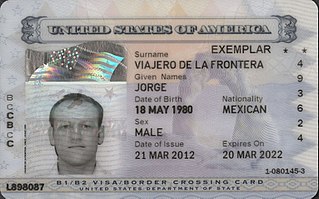 W
WA Border Crossing Card (BCC) is an identity document used by nationals of Mexico to enter the United States. As a standalone document, the BCC allows its holder to visit the border areas of the United States when entering by land or sea directly from Mexico for up to 30 days. The document also functions as a B1/B2 visa when presented with a valid Mexican passport, for entry to any part of the United States by any means of transportation.
 W
WBritish nationality law as it pertains to Hong Kong has been unusual ever since Hong Kong became a British colony in 1842. From its beginning as a sparsely populated trading port to today's cosmopolitan international financial centre and world city of over seven million people, the territory has attracted refugees, immigrants and expatriates alike searching for a new life.
 W
WThe Permanent Resident card is an identification document and a travel document for permanent residents of Canada. It is one of the methods by which Canadian permanent residents can prove their status and is, along with the permanent resident travel document (PRTD), one of the only documents that allow permanent residents to return to Canada by a commercial carrier.
 W
WThe Carnet de Passages en Douane is a customs document that identifies a traveller's motor vehicle or other valuable equipment or baggage. It is required in order to take a motor vehicle into a significant but diminishing number of countries around the world.
 W
WA certificate of identity, sometimes called an alien's passport, is a travel document issued by a country to non-citizens residing within their borders who are stateless persons or otherwise unable to obtain a passport from their state of nationality. Some states also issue certificates of identity to their own citizens as a form of emergency passport or otherwise in lieu of a passport. The visa requirements of certificates of identity may be different from those of regular passports.
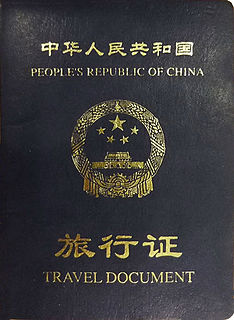 W
WPeople's Republic of China Travel Document is a type of travel document issued by Chinese embassies, consulates, and other foreign offices to Chinese citizens for their international travel to China and other countries. The bearer of the Travel Document is legally defined a Chinese citizen in accordance with the Nationality Law.
 W
WA circular letter of credit was a letter of credit issued by a bank or related financial institution to a private person, usually an individual of means, which enabled that person to draw funds from correspondent banks while traveling. This was considered safer than carrying large sums of cash. Early examples of the use of personal letters of credit can be found as far back as the Renaissance and they became more standardized by the latter half of the 18th century. Circular letters of credit were widely used until the 1970s. However, with the advent of modern electronic banking and ATMs they have largely fallen into disuse.
 W
WA Curfew Pass or Movement and Curfew Pass is a document issued by an empowered authority such as police or military for public officials or civilians to travel within or to and from an area under an imposed curfew by the said authority.
 W
WAn enhanced driver's licence or enhanced ID in common usage, is a card which functions both as driving licence and ID card with limited passport features issued in some provinces in Canada, in some states in the United States, and for the people who are both citizens of the country and residents in the relevant region, compliant with the Western Hemisphere Travel Initiative.
 W
WAn Estonian Alien's Passport is a travel document that may be issued to a person who is stateless or of undefined citizenship residing in Estonia by the Police and Border Guard Board of the Ministry of Internal Affairs. It can also be used as an identity document. Estonia has about 80,000 to 90,000 alien's passports.
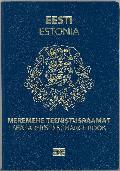 W
WAn Estonian seafarer's discharge book is an identity document issued by Estonian Police and Border Guard Board in which the name, date of birth or personal identification code, and a photograph or facial image and the signature or image of signature of the holder are entered, unless otherwise provided by law or legislation established on the basis thereof. A seafarer who is an Estonian citizen shall be issued a seafarer’s discharge book which complies with the requirements of the “Convention concerning Seafarers’ National Identity Documents” of the International Labour Organisation (ILO). A seafarer’s discharge book shall be issued with a period of validity of up to five years.
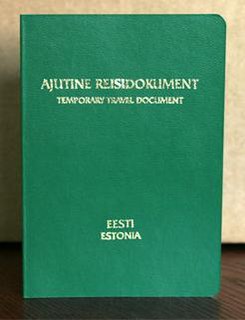 W
WAn Estonian temporary travel document is a travel document issued to an alien staying in Estonia for departure from and return to Estonia. A temporary travel document may be issued, without a standard application, to an alien who departs or is obliged to depart from Estonia without the right of return if he or she does not hold a valid travel document or a certificate of return issued by a foreign state. A temporary travel document for a single departure from and return to Estonia may be issued to an alien legally residing in Estonia if he or she does not hold a valid travel document and does not have the right to receive an alien’s passport. A temporary travel document does not grant the holder thereof the right to protection by a foreign mission of Estonia unless otherwise provided by law or a treaty. A temporary travel document shall be issued with a period of validity of up to two years.
 W
WThe Police and Border Guard Board, a government agency under the Ministry of Internal Affairs in Estonia, issues a variety of travel documents to Estonian nationals and other foreign nationals living in Estonia to facilitate travel outside of Estonia.
 W
WSince the 1980s, member states of the European Union have started to harmonise aspects of the designs of their ordinary passports, as well as common security features and biometrics.
 W
WA European Union laissez-passer is a travel document issued to civil servants and members of the institutions of the European Union. It is proof of privileges and immunities the holders enjoy. The document is valid in all countries of the European Union as well as in over 100 other countries. In 2006, the European Commission issued or renewed 2,200 laissez-passer, and other agencies may issue the document as well.
 W
WThe Exit-Entry Permit for Travelling to and from Hong Kong and Macau, colloquially known as a Two-way Permit or EEP is issued to Chinese nationals with residency in Mainland China as a travel document for the sole purpose to travel the Chinese Special Administrative Regions of Hong Kong and Macau. The Bureau of Exit and Entry Administration of the Chinese Ministry of Public Security is responsible for the issuing of Two-way Permits and exit endorsements.
 W
WA fake passport is a counterfeit of a passport issued by a nation or authorised agency. Such counterfeits are copies of genuine passports, or illicitly modified genuine passports made by unauthorized persons, sometimes called cobblers. Its purpose is to be used deceptively as if it were a legitimate travel or identity document. A passport obtained from an authorized issuer by providing false information may also be considered fake.
 W
WIndefinite leave to remain (ILR) or permanent residency (PR) is an immigration status granted to a person who does not hold the right of abode in the United Kingdom (UK), but who has been admitted to the UK without any time limit on their stay and who is free to take up employment, engage in business, self-employment, or study. When indefinite leave is granted to persons outside the United Kingdom it is known as indefinite leave to enter (ILE).
 W
WThe International Certificate of Vaccination or Prophylaxis (ICVP), also known as the Carte Jaune or Yellow Card, is an official vaccination report created by the World Health Organization (WHO). As a travel document, it is a kind of medical passport that is recognised internationally and may be required for entry to certain countries where there are increased health risks for travellers.
 W
WAn International Driving Permit (IDP), often referred to as an international driving licence, is a translation of a domestic driving licence that allows the holder to drive a private motor vehicle in any country or jurisdiction that recognises the document. The term International Driving Permit was first mentioned in the document prescribed in the International Convention relative to Motor Traffic that was signed at Paris in 1926, and is a translation of the French 'permis de conduire international', or 'international driving licence'. The Paris treaty, and all subsequent, use the word 'permit' exclusively in relation to all kinds of driving licence.
 W
WThe Japan Re-entry Permit (再入国許可書), is a travel document similar to a certificate of identity, issued by Japan's Ministry of Justice. It is a passport-like booklet with a light brown cover with the words "再入国許可書 RE-ENTRY PERMIT TO JAPAN" on the front.
 W
WThe Japan Refugee Travel Document (難民旅行証明書), is a travel document issued by Japan's Ministry of Justice. It is a passport-like booklet with a dark blue cover with the words "難民旅行証明書 REFUGEE TRAVEL DOCUMENT" and two black diagonal lines in the upper left on the front.
 W
WJuxtaposed controls are a reciprocal arrangement between Belgium, France, the Netherlands and the United Kingdom whereby border controls on certain cross-Channel routes take place before boarding the train or ferry, rather than upon arrival after disembarkation. With the exception of the Eurotunnel Shuttle route, customs checks remain unaffected by juxtaposed immigration controls and continue to take place upon arrival after disembarkation. Belgium, France and the Netherlands are all member states of the European Union and part of the border-free Schengen Area. The United Kingdom, on the other hand, has never participated in the Schengen Area, even when it was a member state of the European Union. As a result, juxtaposed controls aim to increase the convenience and efficiency of border checks when travelling by train or ferry between the Schengen Area and the UK by removing the need for immigration checks on arrival and by streamlining checks on departure. At the same time, juxtaposed controls are intended to detect and prevent illegal immigration. In 2016, there were over 56,000 instances when people were refused entry to the UK at the juxtaposed controls.
 W
WThe Mainland Travel Permit for Taiwan Residents, also known as Taiwan Compatriot Permit, is a type of travel document issued by Government of the People's Republic of China (PRC) to the Republic of China nationals (ROC) who hold household registration in Taiwan. The document is issued by the Ministry of Public Security (MPS). Since the identity documents issued by the government of the Republic of China are not recognized in the PRC, the permit serves as both the main travel document and identity document for Taiwanese people in the PRC territory and is used in all occasions in lieu of the Taiwan passport.
 W
WThe Mediterranean pass was a document which identified a ship as being protected under a treaty with states of the Barbary Coast. Such a treaty exacted tribute in exchange for protection from Barbary pirates capturing that country's ships and crews. These passes identified ships which had safe passage.
 W
WNational identity cards are issued to their citizens by the governments of all European Economic Area (EEA) member states except Denmark, Iceland and Ireland. Ireland however issues a passport card which is a valid document in the EEA and Switzerland. Denmark and Iceland issue simpler identity cards that are not valid as travel documents. From 2 August 2021, new identity cards are harmonized as a common identity card model replaced the various formats already in use.
 W
WThe New Zealand Certificate of Identity is an international biometric travel document issued by the Department of Internal Affairs to an alien resident of or visitor to New Zealand who is unable to obtain a national passport, or has a national passport unacceptable to Immigration New Zealand so that they can leave New Zealand. It is not usually issued to a person whose government is represented in either New Zealand or Australia.
 W
WThe Norwegian identity card, commonly referred to as the national identity card in Norway, is a non-compulsory biometric identity document issued since 30 November 2020. It is one of two official identity documents issued by the Norwegian Police Service, the other being the Norwegian passport. It is only issued to Norwegian citizens, and may indicate citizenship so that it can be used as a travel document facilitating freedom of movement within the European Free Trade Association and the European Economic Area. For travel within the Nordic countries no identity documentation is legally required for Nordic citizens due to the Nordic Passport Union.
 W
WThe Open Balkan is an economic and political zone of three member states in the Balkans, including Albania, North Macedonia and Serbia. The zone has a total area of 131,935 km2 (50,940 sq mi) and an estimated total population of almost 12 million. The official languages are Albanian, Macedonian and Serbian. Its administrative centres are the cities of Belgrade, Skopje and Tirana. With the establishment of the zone, all three member states aim to increase trade and co-operation as well as improve bilateral relations.
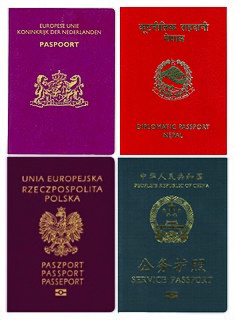 W
WA passport is an official governmental document that contains a given person's identity. It helps its holder travel under its protection to and from foreign countries. The document certifies the personal identity and nationality of its holder. Standard passports contain the full name, photograph, place and date of birth, signature, and the expiration date of the passport.
 W
WA passport stamp is an inked impression in a passport typically made by rubber stamp upon entering or exiting a territory.
 W
WThe Schengen Agreement is a treaty which led to the creation of Europe's Schengen Area, in which internal border checks have largely been abolished. It was signed on 14 June 1985, near the town of Schengen, Luxembourg, by five of the ten member states of the then European Economic Community. It proposed measures intended to gradually abolish border checks at the signatories' common borders, including reduced-speed vehicle checks which allowed vehicles to cross borders without stopping, allowing residents in border areas freedom to cross borders away from fixed checkpoints, and the harmonisation of visa policies.
 W
WThe Schengen Area is an area comprising 26 European countries that have officially abolished all passport and all other types of border control at their mutual borders. The area mostly functions as a single jurisdiction for international travel purposes, with a common visa policy. The area is named after the 1985 Schengen Agreement signed in Schengen, Luxembourg.
 W
WThe Secure Electronic Network for Travelers Rapid Inspection (SENTRI) provides expedited U.S. Customs and Border Protection (CBP) processing, at the U.S.-Mexico border, of pre-approved travelers considered low-risk. Voluntarily applicants must undergo a thorough background check against criminal, customs, immigration, law enforcement, and terrorist databases; a 10-fingerprint law enforcement check; and a personal interview with a CBP Officer. The total enrollment fee is $122.50, and SENTRI status is valid for 5 years.
 W
WThe Sovereign Military Order of Malta passport is a travel document issued to officials and diplomats of the Sovereign Military Order of Malta (SMOM). The order issues biometric passports which are fully ICAO9303 compliant.
 W
WTimatic is a database containing documentation requirements for passengers traveling internationally via air, e.g. passport and visa requirements. Timatic, an abbreviation for Travel Information Manual Automatic, is used by airlines and their representatives, airport staff, and travel agents to determine whether a passenger can be carried, as well as by airlines and travel agents to provide this information to travellers at the time of booking. This is critical for airlines due to the fines levied by immigration authorities every time a passenger is carried who does not have the correct travel documentation, as well as the airline's costs to return the incorrectly-boarded passenger to the original airport from which the passenger departed.
 W
WA visa is a conditional authorization granted by a territory to a foreigner, allowing them to enter, remain within, or to leave that territory. Visas typically may include limits on the duration of the foreigner's stay, areas within the country they may enter, the dates they may enter, the number of permitted visits or an individual's right to work in the country in question. Visas are associated with the request for permission to enter a territory and thus are, in most countries, distinct from actual formal permission for an alien to enter and remain in the country. In each instance, a visa is subject to entry permission by an immigration official at the time of actual entry, and can be revoked at any time. Visa evidence most commonly takes the form of a sticker endorsed in the applicant's passport or other travel document but may also exist electronically. Some countries no longer issue physical visa evidence, instead recording details only in immigration databases.
 W
WThe Re-entry Permit is a travel document similar to a certificate of identity, issued by the United States Citizenship and Immigration Services to U.S. lawful permanent residents to allow them to travel abroad and return to the United States. It is a passport-like booklet with a blue-green cover with the words "TRAVEL DOCUMENT" on the front. Individuals whose application for permanent residency has not yet been approved can instead apply for advance parole.
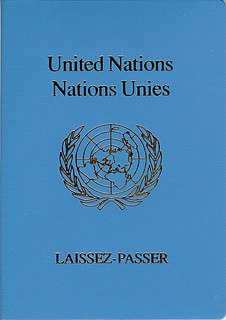 W
WA United Nations laissez-passer is a diplomatic travel document issued by the United Nations under the provisions of Article VII of the 1946 Convention on the Privileges and Immunities of the United Nations in its offices in New York and Geneva, as well as by the International Labour Organization (ILO).
 W
WThe United States passport card is an optional national identity card and a travel document issued by the United States federal government in the size of a credit card. Like a U.S. passport book, the passport card is only issued to U.S. nationals exclusively by the U.S. Department of State, compliant to the standards for identity documents set by the REAL ID Act, and can be used as proof of U.S. citizenship and identity. The passport card allows its holders to travel by domestic air flights within the United States, and to travel by land and sea within North America. However, the passport card cannot be used for international air travel.
 W
WThe visa policy of Australia deals with the requirements that a foreign national wishing to enter Australia must meet to obtain a visa, which is a permit to travel, to enter and remain in the country. A visa may also entitle the visa holder to other privileges, such as a right to work, study, etc. and may be subject to conditions.
 W
WThe Western Hemisphere Travel Initiative (WHTI) is the implementation of the requirement to show a passport or other acceptable document to enter the United States, for nationals of certain North American jurisdictions who were previously exempt from it when traveling within the Americas. The requirement was mandated by the Intelligence Reform and Terrorism Prevention Act, enacted in 2004 in response to the terrorist attacks of September 11, 2001, and implemented in phases between 2007 and 2009. According to the U.S. Department of Homeland Security, the purpose is to strengthen border security and facilitate entry into the United States for both U.S. citizens and foreign visitors.